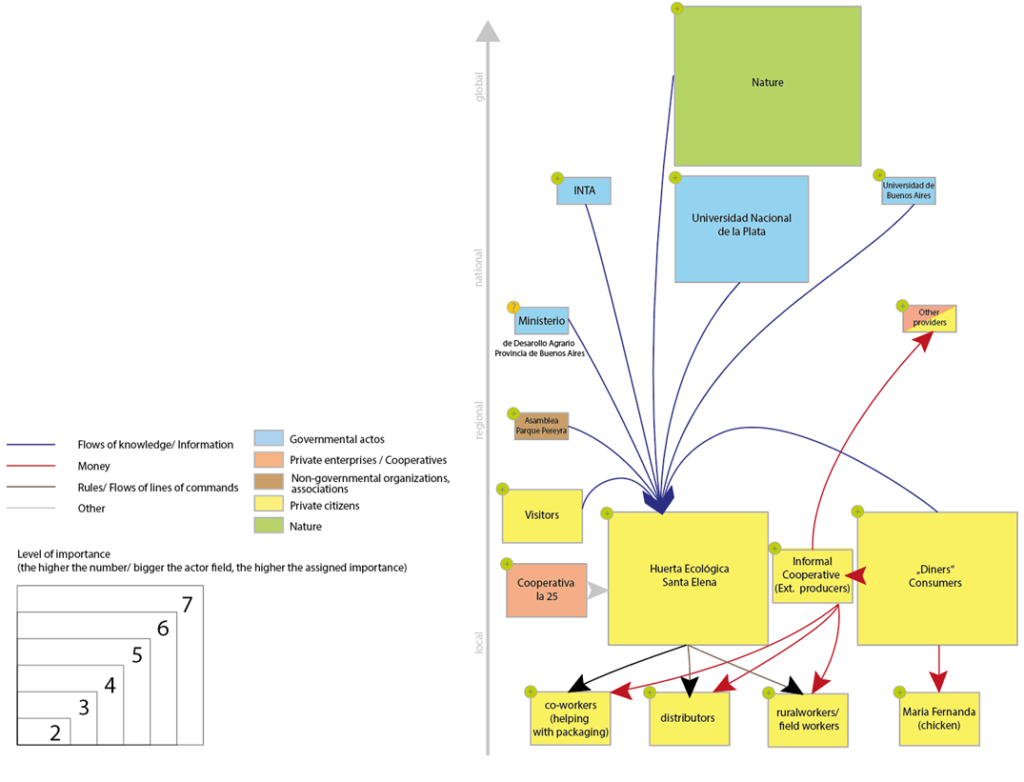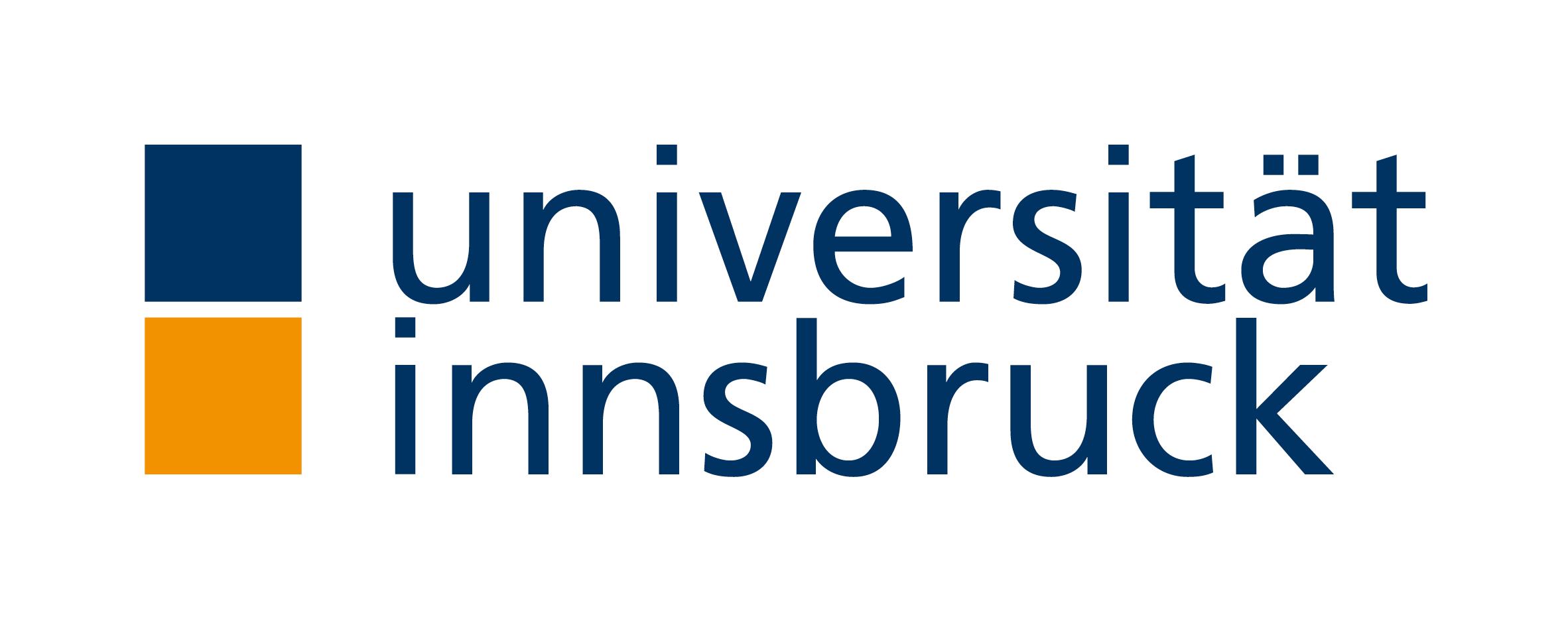Influence Mapping of Social Networks by Eva Schiffer; adapted for foodalternatives.at initiatives by Anna-Maria Brunner.
What is needed?
- DIN A2 white paper sheet
- Coloured paper or post-it (blue, red, yellow, green, brown) for actor cards
- Felt pens (dark blue/ violet, red, grey, black) for drawing linkages
- Glue/ tape/ Patafix
- Building blocks (recommended 2×2 lego brick) for importance-towers
- Recording device
- 1 – 1.5h time availability
Preparation
- Pre-cut the actor cards (not applicable when using post-it).
- Ask for recording permission and prepare a recording device.
- Add a legend to the blank paper sheet including information about the interview (name, date, place) and indicating the meaning of the colours used:
- Cards: Suggested categories & colour assignments
- Blue cards: Governmental actors
- Brown cards: NGOs
- Red cards: Private enterprises / Cooperatives
- Yellow cards: Private citizens
- Green card: Nature
- Lines: Suggested categories & colour assignments
- Black line: Rules/ Flows of lines of command
- Dark blue/ violet line: Flows of knowledge/ information
- Red line: Fluxes of money
- Grey line: Other (open category for important connections interviewees might want to add; in that case, indicate the type of connection next to the arrow)
- Cards: Suggested categories & colour assignments
Goal
To answer the questions:
„Whom do initiatives perceive as influential actors (enhancing or impeding the projects‘ success)?“ „Where do conflicts or struggles arise?“
To gain better insights into network constellations (who plays a [minor/ powerful] role) and actor relations (who is closely linked/ how).
Procedure (5 steps/ 4 guiding questions):
1. Who is involved?
This first question, getting the NetMapping process started, aims at gathering all the actors playing a role in the respective case study.
1.1 Write down all the named actors onto actor cards of the respective colour (e.g., blue cards/ post-it for governmental actors) and place the cards on the poster paper
1.2 When no more actors are being named, give a closer explanation of who can be understood as an actor, like:
Actors could be individuals (with or without decision-making-power), groups, social movements, (governmental and non-governmental) organizations, and institutions. Name every actor that comes to your mind (not only those who have formal decisionmaking capacity in the process).
Usually, after this additional inspiration, further actors are named. Add those actors to the poster paper.
1.3 Before continuing with step 2, read aloud all the so-far gathered actors on the poster. This might lead to further actors coming the interviewee to mind.
Note 1: Interviewees might or might not add themselves to the list of actors.
Note 2: Open process: Interviewees are allowed to add actors throughout the whole interview.
2. How are they linked? What lines of connection exist between the stated actors?
Use the felt pens to draw
- flows of lines of command, rules (black)
- flows of knowledge/ information (dark blue/ violet)
- fluxes of money (red)
- other linkages- open category (grey)
between the respective actors. Make the direction of fluxes clear by drawing arrows of linkages originating from one actor and pointing to another actor on the poster.
2.1 Start asking about and drawing linkages of the category you expect to be the least common.
2.2 Proceed with asking about lines of connections of the other categories. If more than one line of connection exists between two actors, add another arrowhead in the respective colour to the existing arrow to keep the number of lines to a minimum for a clearer picture.
2.3 Read out loud the connections between the actors and ask the interviewee if the picture is complete or if adaptations need to be made.
3. How influential are they?
This third step asks about how much influence an actor has on the specific initiative (not generally speaking). Sources of influence could range from legitimate decisionmaking power; through giving advice, incentives or funding; to bending or breaking the rules.
3.1 Ask your interview partner to assign „towers of importance“ to all the actors displayed on the poster, using the provided building bricks (e.g., Lego):
- The higher the tower, the more influence an actor has.
- No pre-defined range: Towers can be as high as the interviewee wants.
- If perceived as equally important, actors can have towers of the same height.
- If actors are perceived as not influential, no influence tower has to be built.
3.2 After setting up the influence towers, verbalize what you see. Start reading out the actors with the highest tower, mentioning if two actors were attributed the same amount of importance, then move to the actors rated as less important. Encourage the interviewee to adjust anything if he or she has second thoughts. If you change one tower, make sure to adjust the others accordingly until the importance towers accurately mirror the interviewee’s perception of the actors.
3.3 Once the interviewee is content with the whole set-up, read aloud the assigned importance and note the height of the influence towers next to the actors‘ names on the network map.
4. What are their goals?
Step 4 aims at pointing at the specific pre-defined goals of each actor on the network map.
What are the actors aiming at? Do the actors‘ goals align with those of the respective initiative or are they conflicting? Do the underlying values match/do they work towards the same mission?
4.1 Go through all the actors, starting with the most influential actor. Note the actors‘ goals in keywords underneath the respective actor card.
4.2 Talk through the actors again and summarize their goals and positions in regard to the initiative’s goals. Write down plus/ neutral/ minus signs (possibly also question marks in case of unclarity) on the actor cards, indicating whether the actors support or contradict the initiative’s goals.
5. Discussion
Talk with your interviewee about the created map. Verbalize all the interesting constellations, connections, similarities, patterns, groupings, and contradictions depicted on the map and talk through them with your interview partner. Ask additional questions to gain a better understanding, e.g., drawing on the sources and effects of influence. For example:
I see you have put this actor on the highest tower. Why? Where does his/her influence come from? You say that these two have the same level of influence. What happens if they disagree? Is their influence based on the same grounds? Does it have the same range? I have heard there is a conflict between these three actors. Could you explain to me what it is about? You have linked this actor to so many others, but you say he doesn’t have much influence— why is that so?
Post Processing/ Visualization
Visualize the Net-Map outcome digitally (e.g., using Adobe llustrator) using the following variables:
- Colour of the actor cards: Indicates the type of actor
- Blue cards: Governmental actors
- Brown cards: NGOs
- Red cards: Private enterprises / Cooperatives
- Yellow cards: Private citizens
- Green card: Nature
- Size of actor cards: Indicates the influence of actors (originally influence tower). The size of the actor cards should be proportional to the assigned importance (the bigger, the more important).
- Position of actor cards (vertically):allocates the actors on the corresponding scale level
Moving from the bottom upwards: local – regional/ provincial – national – supranational
à the distance between actors does NOT mirror their actual closeness. - Position of cards (horizontally)/ within one scale level: arrange in a way to create the clearest possible picture (as few crossing arrows as possible); the distance between actors does NOT mirror their actual closeness.
- Colour of arrows: Indicates the type of connection between two actors
- Black line: Rules/ Flows of lines of command
- Dark blue/ violet line: Flows of knowledge/ information
- Red line: Fluxes of money
- Grey line: Other (open category for important connections interviewees might want to add; in that case, indicate the type of connection next to the arrow)
- Direction arrows: indicates the direction of fluxes and flows (e.g. Actor A providing information to actor B).
- Plus/ neutral/ minus sign and question marks (on the top left corner of actor cards): indicate whether the actor supports or contradicts the initiative’s goals.




